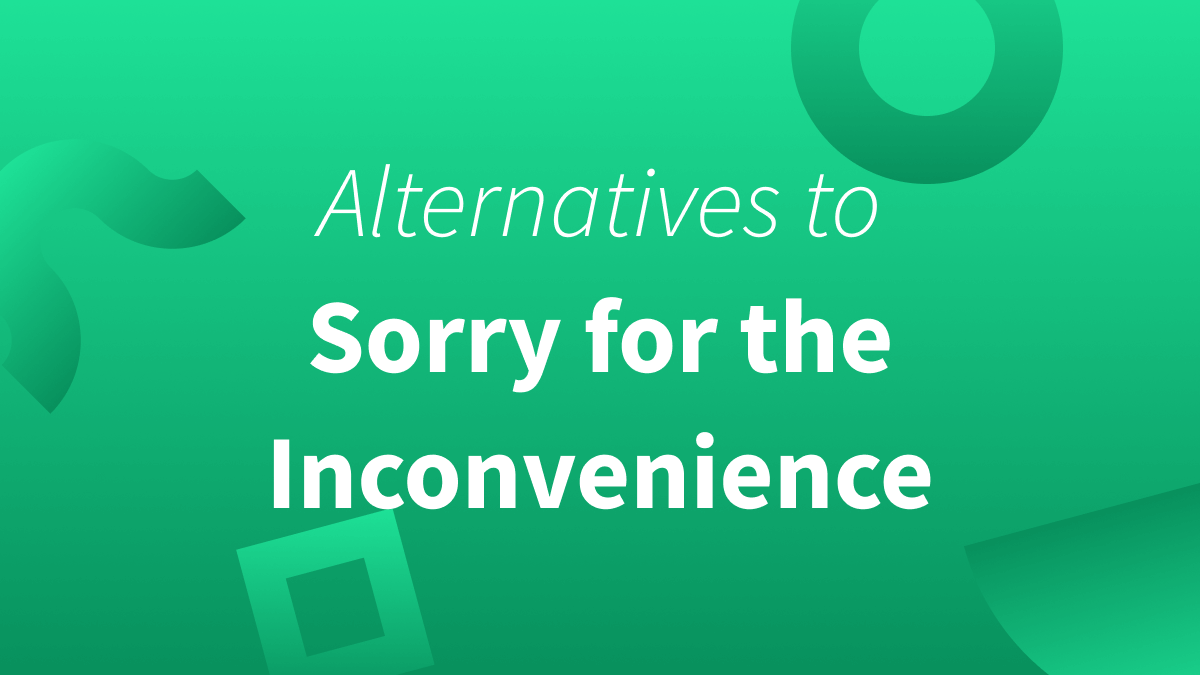Sorry for the Inconvenience Alternatives
- Using sorry for the inconvenience in an email when you have made a mistake can appear formulaic and insincere. Instead, try using these alternatives:
- An effective email apology should include a sense of urgency, a solution, and assurance that the error won’t happen again.
- ○ I sincerely apologize for this oversight.
- ○ Please accept my sincere apology.
- ○ I understand your frustration.
- ○ Please excuse…
- ○ This shouldn’t have happened.
Sorry, Not Sorry
Sorry for the inconvenience.
That’s a common email phrase you’ve probably used or have come across often. It’s a copy-and-paste expression that’s used daily by entrepreneurs, companies (and their employees), students, colleagues, and more.
It’s used so frequently, and in so many different situations, that the expression has lost its genuineness. You can use it if you’d like, sure, but you run the risk of appearing as if you’re apologizing simply because you have to.
If you want to let the recipient of your email know you’re truly sorry, use any of the alternatives found below.

Alternatives to “Sorry for the Inconvenience”
After the formal salutation, you can use any of the following options in place of sorry for the inconvenience.
1. “I sincerely apologize for this oversight.”
Oversight is a noun that means “an unintentional failure to notice something which caused an error.” This phrase is similar to sorry for the inconvenience and can be used the same way.
Dear Mr. Toler,
I sincerely apologize for this oversight. My team should have noticed that the wrong item was packaged and delivered to you.
This alternative is best used when apologizing for a mistake you (or someone on your team) made on behalf of the business.
2. “Please accept my sincere apology.”
This alternative is perfect to use when you want to accentuate that you’re sincerely sorry. It’s especially useful when the error is a rather large one compared to one that is a minor inconvenience.
Dear Mrs. Epps,
Please accept my sincere apology. There was an error in the accounting department which led to your card being charged three times.
3. “I understand your frustration.”
Part of a sincere apology is being able to empathize with whoever was on the receiving end of the error. Not only does this show you understand their frustration, but it also makes the recipient feel heard. Remember that if you use this alternative, you should still explicitly apologize somewhere else in the email.
Dear Ms. Rothstein,
I understand your frustration. A shipping delay can cause a chain reaction of other serious inconveniences.
4. “Please excuse…”
Please excuse is an especially formal alternative to sorry for the inconvenience. It’s a suitable alternative to use in professional and academic settings, like when writing to a client or to a professor.
Dear Mr. Patton,
Please excuse the delay in processing the payment.
5. “This shouldn’t have happened.”
This shouldn’t have happened is another way to show that you’re aware a mistake was made. Explicitly stating fault in something can help the recipient feel understood and therefore less upset. As with I understand your frustration, you should still write I’m sorry (or another variation) somewhere in the email.
Dear Thomas,
This shouldn’t have happened. Our team is trained to catch these types of discrepancies. We are sorry and can assure you that this mistake won’t happen again.
Tips for Writing an Apology Email
There are a few other tips you can keep in mind that’ll help you write an email that shows you’re truly sorry.
1. Include a sense of urgency.
No one likes feeling like they are being put on the back burner. If you or someone on your team has made a mistake, clarify that you’re doing everything you can to rectify the situation right away.
2. Offer a solution.
Let the reader know what you’re doing to fix the mistake. If the mistake is something you personally cannot fix, let them know that you’ve contacted someone who can help find a solution.
3. Provide assurance that the mistake won’t happen again.
Mistakes happen. What’s important is that you emphasize that it won’t happen again. If you’d like, you can elucidate how you’re ensuring that the error was a one-time incident.
4. Thank the recipient for their patience.
Let the reader of the email know that you’re truly appreciative of their patience. Doing so can help soften the blow of the mistake and initial inconvenience.
5. Use LanguageTool to help enhance style and tone.
Using the optimal wording and tone makes all the difference in your apology email. LanguageTool not only ensures that your email is free of spelling and grammar errors, but it can also rephrase sentences to match the style and tone that best suits the audience. This can help show that your apology is sincere.

